“Global Ultra Wideband Market to reach a market value of USD 4.9 Billion by 2031 growing at a CAGR of 18.2%”
The Global Ultra Wideband Market size is expected to reach $4.9 billion by 2031, rising at a market growth of 18.2% CAGR during the forecast period.
UWB technology enhances the operation of automated and collaborative robots by providing accurate positioning and collision avoidance capabilities. This enables robots to work alongside human operators and other machines with greater precision, improving efficiency and flexibility in manufacturing processes. UWB can provide precise measurements and inspections in quality control and testing applications. This includes monitoring the alignment and positioning of components, detecting defects, and ensuring the accuracy of manufacturing processes. Thus, the manufacturing segment held 18% revenue share in the market in 2023.
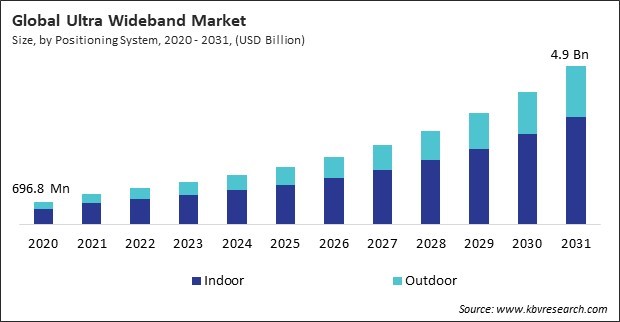
The major strategies followed by the market participants are Product Launches as the key developmental strategy to keep pace with the changing demands of end users. For instance, In February, 2024, Qualcomm introduced the FastConnect 7900, the first AI-optimized Wi-Fi 7 system integrating Wi-Fi, Bluetooth, and it on a single chip. This innovation enhances connectivity and proximity features like digital keys and indoor navigation, with a commercial launch planned for late 2024. Additionally, In November, 2023, NXP Semiconductors has unveiled the Trimension NCJ29D6, an advanced automotive UWB chip that integrates secure localization with short-range radar. Designed for applications such as car access and child detection, it aims for 2025 vehicle integration, improving performance, security, and cost efficiency.
Based on the Analysis presented in the KBV Cardinal matrix; Apple, Inc. is the forerunner in the Ultra Wideband Market. Companies such as Qorvo, Inc., Samsung Electronics Co., Ltd., and STMicroelectronics N.V. are some of the key innovators in Ultra Wideband Market. In September, 2023, Apple Inc. has upgraded its Watch Series 9 and Watch Ultra 2 with a second-generation UWB chip, enhancing precision location services for integration with Home Pod and iPhone. This advancement underscores UWB’s expanding role in high-precision applications, including keyless entry and contactless payments.
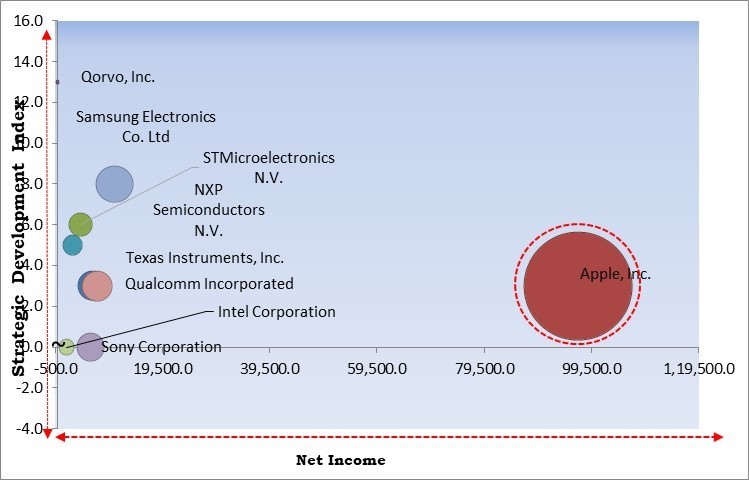
As smart technologies and connected devices become more prevalent, there is a greater need for precise location services to enable seamless interactions and functionality. UWB supports advanced smart home features, such as automated lighting and security systems, by providing accurate location data to trigger actions based on user presence or movement.
Additionally, UWB improves the user experience in smart environments by enabling precise indoor navigation, location-based services, and context-aware interactions. This enhances the functionality of smart homes, offices, and public spaces, making them more responsive to user needs. In conclusion, IoT and Smart Infrastructure growth drive the market’s growth.
For large-scale deployments, such as in smart cities or extensive industrial environments, the short range of UWB necessitates the installation of numerous UWB nodes or anchors to ensure comprehensive coverage. This can lead to increased costs and complexity in setting up and maintaining the UWB infrastructure. Therefore, short-range limitations are hampering the market’s growth.
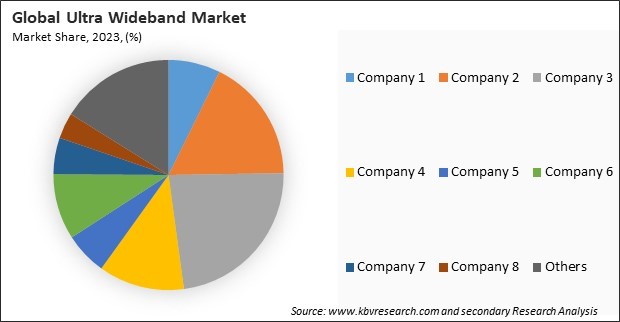
The leading players in the market are competing with diverse innovative offerings to remain competitive in the market. The above illustration shows the percentage of revenue shared by some of the leading companies in the market. The leading players of the market are adopting various strategies in order to cater demand coming from the different industries. The key developmental strategies in the market are Product Launches and Product Expansions.
Based on positioning system, the market is divided into indoor and outdoor. In 2023, the indoor segment garnered 70% revenue share in the market. UWB technology offers unparalleled accuracy in indoor positioning, often within a few centimeters. This level of precision is crucial in environments where traditional GPS systems are ineffective, such as large buildings, warehouses, shopping malls, and hospitals.
On the basis of application, the market is segmented into real-time location system (RTLS), imaging, and communication. In 2023, the imaging segment attained 32% revenue share in the market. UWB technology offers the ability to achieve high-resolution imaging by providing detailed information on objects’ spatial and temporal dimensions.
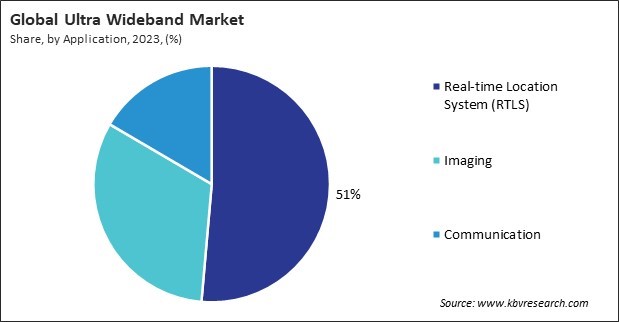
By end use, the market is divided into consumer electronics, automotive & transportation, manufacturing, residential, and others. In 2023, the consumer electronics segment registered 37% revenue share in the market. Consumer electronics, including smartphones, smartwatches, and smart home devices, can benefit from the highly precise location-tracking capabilities of UWB.
Free Valuable Insights: Global Ultra Wideband Market size to reach USD 4.9 Billion by 2031
Region-wise, the market is analyzed across North America, Europe, Asia Pacific, and LAMEA. In 2023, the Asia Pacific region generated 31% revenue share in the market. APAC is seeing increased investment in research and development from both government and private sectors.
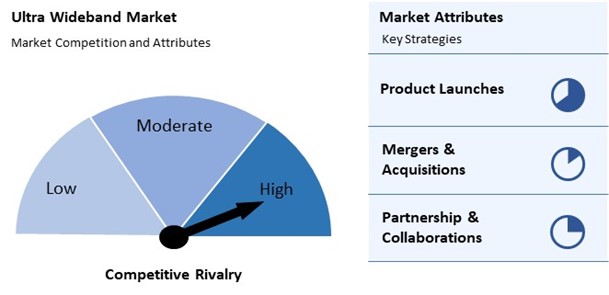
The Ultra Wideband (UWB) market is highly competitive, with prominent players like Apple, Samsung, and Decawave (Qorvo) leading innovation. Key attributes include precision in location tracking, low power consumption, and high data transfer rates, making UWB ideal for applications in indoor positioning, smart devices, and automotive systems.
| Report Attribute | Details |
|---|---|
| Market size value in 2023 | USD 1.3 Billion |
| Market size forecast in 2031 | USD 4.9 Billion |
| Base Year | 2023 |
| Historical Period | 2020 to 2022 |
| Forecast Period | 2024 to 2031 |
| Revenue Growth Rate | CAGR of 18.2% from 2024 to 2031 |
| Number of Pages | 240 |
| Number of Tables | 363 |
| Report coverage | Market Trends, Revenue Estimation and Forecast, Segmentation Analysis, Regional and Country Breakdown, Competitive Landscape, Market Share Analysis, Porter’s 5 Forces Analysis, Company Profiling, Companies Strategic Developments, SWOT Analysis, Winning Imperatives |
| Segments covered | Positioning System, Application , End Use , Region |
| Country scope |
|
| Companies Included | Qorvo, Inc., NXP Semiconductors N.V., Texas Instruments, Inc., Apple, Inc., Samsung Electronics Co. Ltd, Johanson Technology, Inc., Sony Corporation, Qualcomm Incorporated (Qualcomm Technologies, Inc.), STMicroelectronics N.V. and Intel Corporation |
By Positioning System
By Application
By End Use
By Geography
This Market size is expected to reach $4.9 billion by 2031.
Growing demand for precision location services are driving the Market in coming years, however, High Initial Costs of the UWB restraints the growth of the Market.
Qorvo, Inc., NXP Semiconductors N.V., Texas Instruments, Inc., Apple, Inc., Samsung Electronics Co. Ltd, Johanson Technology, Inc., Sony Corporation, Qualcomm Incorporated (Qualcomm Technologies, Inc.), STMicroelectronics N.V. and Intel Corporation
The expected CAGR of this Market is 18.2% from 2024 to 2031.
The Real-time Location System (RTLS) segment is leading the Market by Application in 2023; thereby, achieving a market value of $2.5 billion by 2031.
The North America region dominated the Market by Region in 2023, and would continue to be a dominant market till 2031; thereby, achieving a market value of $1.6 billion by 2031.
Our team of dedicated experts can provide you with attractive expansion opportunities for your business.

 Drivers
Drivers
 Restraints
Restraints
 Opportunities
Opportunities
 Challenges
Challenges
